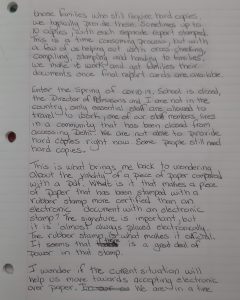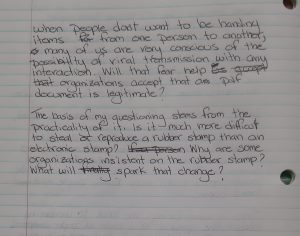


It has been a long time since I wrote this many paragraphs manually, I am definitely more accustomed to typing. The writing itself wasn’t too difficult, although there was some concern that my hand might get tired. Since I picked a topic that I have been thinking about recently, it was easy to come up with enough thoughts to fill the pages.
The more challenging aspect of the task for me was the editing. When I write on a computer, I tend to edit and adjust as I go along. I’ve already reworded the previous sentence a few times, and it may be reworked again by the time I submit this. During the task, when I made a mistake or wanted to adjust a word, my only option was to cross out words and write in the new ones. This limited the amount of editing that I did. I had considered double-spacing, but realized that would produce 6 notebook pages of writing and felt that would be too much. Double-spacing in the notebook would have provided more space for editing and may have enabled me to move words around a bit more, but the appearance of the finished story would have been less easy to read.
To me the most significant difference between writing by hand and using a computer is the forethought that is required. When writing on a computer, it is simple to move ideas around, adjust paragraphs, and then move them back again. With handwriting, there is more time and effort required to move around and play with the wording and style. This doesn’t necessarily mean that one method is superior. It could be said that the simplicity of editing computer documents makes me more complacent about the planning and outline. Perhaps the preparation that goes into a quality handwritten text can produce a more thoughtful piece of work.
I think you are correct to say that a hand written piece is a more thoughtful piece Janice. I do most of my rough work on paper as a grade school teacher, but lessons are all stored in folders on my computer desktop now a days. No more binders filled with paper. Although I have 99% of my work on computer, the ones I am most proud of are still hand written by me as a young teacher. I only saved the very best so maybe that has something to do with my investment in the handwritten lessons and the emotional attachment I have to these sheets of paper.
Hi Ryan,
Thanks for your thoughts. Going through the handwriting exercise did make me consider how much things have changed with how we plan and execute written tasks. As much as I do not want those binders of paper around, it is nice to be able to look back at our own written work from years ago. I wonder what we are losing by not having as much of that. Is it just nostalgia or is there something else to it?
Hi Janice;
I appreciated your thoughts on the efficiency and sustainability of paper vs pdf. I can relate to the frustration of feeling buried by piles of paper that seem to accumulate and multiply when I’m not looking. Problematically, I find that I sometimes need the tactile nature of working with pen and paper to help my brain synthesise and organise information.
When I was writing my thesis, I was working in an analogue way. My literature review was researched using both pdf copies of articles that I read on my iPad, as well as bound books and anthologies which I diligently carted along with me, but my notes were all taken by hand. I developed a system that used B5 notebooks and colour coding to help me identify titles, subtitles, the names of important people, direct quotations, definitions of important terms, as well as my own thoughts as I synthesised information. When organising my paper, I set up extra tables and re-organised my notes into topics by re-writing points from different articles into the scaffold of how I wanted to express those ideas. Once I had the paper set out physically, I then began writing using a word processor. I needed those physical steps to help my brain create and climb the scaffolding of my dissertation. I was, however, left with several binders of both the notes on specific sources, and separate binders that have my re-written and re-organised notes broken down by topics sitting on my bookshelves even still.
Fast forward one degree, and one evolutionary step forward in my process. I have found a hybrid method. I still make notes by hand when I am reading scholarly sources, and I still sometimes re-organise those ideas by hand before I start writing on a laptop, but my method of storing those notes has changed drastically. I have discovered a re-usable notebook that allows you to scan and store notes digitally. I now have the privilege of using my preferred method of note-taking as well as benefiting from the freedom of always having my digitised notes to hand (in the cloud), and freeing my bookshelves from stacks of paper.
It’s a pretty wonderful vantage to be writing from. Check out Rocketbook if you’re curious.
I definitely think that the way we process information changes based on how we record it, be that in a digital or analogue way. I also think that different brains require different methods. It has been interesting to see what everyone’s take is on the topic!
Suzzie
Hi Suzzie,
Thanks for this detailed explanation, I’m not sure how I missed this a few weeks ago, what a fascinating system and description of reorganizing and its evoloution. It is interesting how individuals need to organize things differently and how the physical act of writing can play a role in our information processing. Your explanation brings to mind tagging and storage that has been enabled through online systems, but of course doesn’t maintain the tactile element. I’m going to check out Rocketbook and see what that is all about. Thanks again for the notes and ideas!